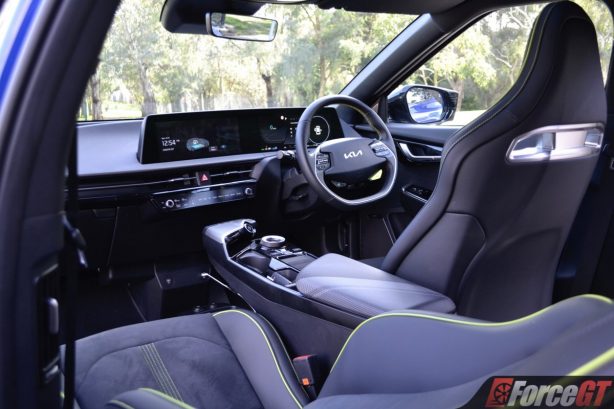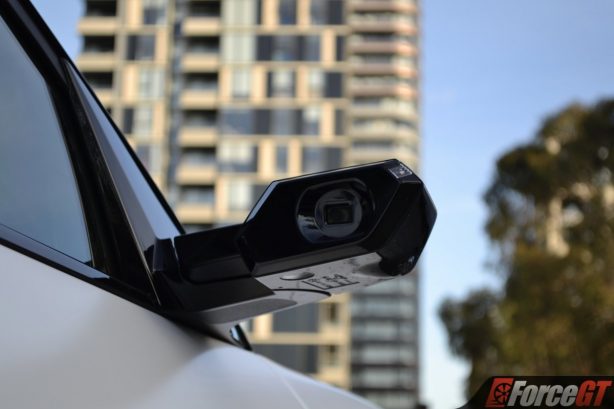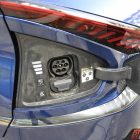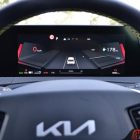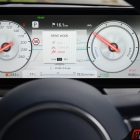There is no shortage of electric cars to choose from these days with nearly every manufacturer offering at least one fully electric vehicle on their showroom floor.
Sales of battery-vehicles are also up approx. 345 per cent year-to-date with Tesla continuing to dominate with its Model Y SUV and Model 3 sedan duo, followed by Chinese-built BYD and MG which are also making significant in-roads.
Kia and its sister brand Hyundai have found relative success too with the EV6 and IONIQ 5 both making it into the Top 10 EV sales chart.
We pitted the two Korean EVs against each other earlier this year (you can read the Kia EV6 GT Line vs Hyundai IONIQ 5 AWD review here) and it was a close one that is hard to split, with both impressing with their built quality, driving range, technology and handling.
Now, we have another contender from the Korean giant. This time from Hyundai’s luxury brand Genesis.
The GV60 enters the ring riding on the same dedicated E-GMP EV platform but a bolder look and a price tag to match. There are two variants in the range, starting with the GV60 AWD priced from $107,700 plus on-road costs, before moving on to the GV60 Performance AWD from $114,700.
They are separated by their electric motors, with the standard all-wheel drive model getting a 74kW front and 160kW rear electric motors (234kW/605Nm combined), while the Performance variant as tested gets a pair of significantly more powerful 180kW front and rear electric motors (360kW/700Nm combined).
Suffice to say, this is plenty powerful and pips its cohorts such as the Lexus RZ 450e, BMW iX3 and Mercedes-Benz EQC.
However, there’s a challenger within its own camp in the form of the Kia EV6 GT. It too has all-wheel drive courtesy of a 160kW front motor, and 270kW rear motor that puts out a combined 430kW/740Nm, making it the most powerful Kia model ever produced.
So, does it make sense to fork out $15,110 more for less power but more luxury? Let’s find out.
Styling
Most would agree you wouldn’t describe the Genesis GV60 as good-looking. It’s curvy and bulbous look isn’t as appealing as the brand’s broader range and certainly no match for the Kia EV6 GT’s stylish and sophisticated sheet metal.
There are eye-catching elements however, such as the busy but smart 21-inch alloy wheels, and integrated rear spoiler that accentuates the rear hatch.
But if you are looking to stand out, the GV60 might fit the bill.
Subjectively, the Kia EV6 GT on the other hand is the classier of the two, although your neighbour would be hard pressed to know you’ve dropped six-figures on your new EV.
Compared to the GT-Line, the full-fat EV6 GT is only distinguished by a set of five-spoke 21-inch wheels behind which hide a set of Neon Green four-piston brake callipers, slightly different front grille and lower front bumper, matrix LED headlights and sequential turn indicators (front and rear), and a rear aero spoiler.
Inside, the GV60 wins with its more dramatic interior, especially the showy rotary gear selector that flips over to become a luminescent crystal ball when the car is off. Its futuristic digital side mirrors and fingerprint authentication system (including starting) will also appeal to younger tech-heads which the car is targeted at.
Circles are certainly the dominant theme here with the door handles, mirror and infotainment controls all taking the circular form.
The 12.3-inch digital instrument and infotainment screen are almost identical to the one in the EV6 (and IONIQ 5) though its unique Genesis skin takes on a lighter tone as opposed to the Kia.
The ‘Neon Green’ colour must be the hue for the season as it is applied to both cars on the seat piping.
Genesis has gone to great lengths to not only differentiate itself from its platform mates but also that of rivals. It’s unique but not to everyone’s taste although that’s not such a bad thing.
Space & Practicality
Both the GV60 and EV6 GT feel light and spacious due to their vast glass house and panoramic glass roof. Their floating centre console offers two cupholders and a storage bin under the centre armrest.
However, unlike the unit in the IONIQ 5, neither of them slides back and forth.
Both cars also have lots of storage areas front and back, including the sizeable space between the dashboard and the centre console, large door pockets with integrated bottle holders, and a fascinating slide-out drawer as a glove box in the GV60.
The cabins are also dotted with up-to-the-minute USB-C ports and a wireless smartphone charger pad at the front.
The second row of seats are just as accommodating and thanks to the electric cars’ flat floors, seating three adults across the bench isn’t as punishing.
There’s 432L of boot space in the GV60 and a more generous 480L in the EV6 GT with the second-row seats in place, which is ideal for family trips. With the second-row seats folded, stowage capacity increase to 1,460L in the GV60 and 1,260L in the EV6 GT. There’s a small frunk at the front for the charging cable, too.
We also like the full-size household-style power outlets under the rear bench of both vehicles, which are handy for plugging in your laptop or other devices to keep productive while charging the cars.
In terms of which is better, they are both good cabins to be in, with the GV60 being the more luxurious one as you’d expect. And while the EV6 GT might lack a few bling, it’s the sportier of the two.
Kia expects owners to take their cars to track-days, as such the front bucket seats are designed to allow for helmets to be worn. The lack of power adjustments also means they can be mounted closer to the floor compared to the higher seating position of the GV60.
In terms of seat comfort, the GV60’s front pew is the more comfortable of the two. The lack of lumber support in the EV6 GT’s driver’s seat means your lower back might start to complain after a few hours.
Features
The Genesis GV60 is the more richly equipped of the two, especially in our range-topping GV60 AWD Performance.
Novel features include Face Connect and Fingerprint Start technology that lets drivers unlock the car using facial recognition and start the vehicle via their fingerprint. The latter also recalls personalisation settings when set-up.
The Performance model also gain the following over the standard GV60:
- Rear limited-slip differential (E-LSD)
- Road-preview adaptive electronic suspension
- Boost Mode
- Virtual gear shirt
- Black monoblock front brakes
Other GV60 AWD Performance features highlight:
- Digital side mirrors
- 18-way power driver’s seat with memory function
- Ergo Motion Massage Function for driver’s seat
- 12-way power front passenger seat
- 3-inch digital instrument
- Head-up display
- Power tilt/telescoping steering wheel
- Heated and ventilated front seats
- Heated outer 2nd row seats
- Heated steering wheel
- Matrix LED headlights
- Power tailgate
- 3-inch HD touchscreen infotainment system
- Navigation with augmented reality (AR) and live traffic
- 17-speaker Bang & Olufsen sound system
- Digital Radio
- Wired Apple CarPlay and Android Auto
- Wireless phone charger
- Genesis Connected Services
- Over-the-air vehicle update
While not as extensively specced, the EV6 GT doesn’t feel under equipped either. Mechanically, it gets the following extra over the GT-Line:
- Electronic controlled suspension
- E-limited slip differential
- 21-inch alloy wheels with Michelin Pilot Sport 4S Tyres
- 380mm ventilated front and 360mm ventilated rear discs
- Four-piston front brake calipers
EV6 GT features highlight:
- Artificial leather and suede sports bucket seats
- Dual curved display (12-3-inch digital instrument + 12.3-inch infotainment)
- Augmented reality Head-up display
- Heated steering wheel
- Heated front seats
- Heated rear outboard seats
- Matrix LED headlights
- Sequential indicators
- Power tailgate
- Inbuilt navigation
- 14-speaker Meridian Sound System
- Digital Radio
- Wire Apple CarPlay and Android Auto
- Wireless phone charger
- GT Mode button on steering wheel
Both also come with the following EV specific features:
- Exterior charge status indicator
- V2L – Vehicle to load interior socket
- V2L – Vehicle to load exterior adaptor (Type 2 to Australian type socket)
- Regenerative braking control via paddle shifters (Levels 0-3)
- i-Pedal – One pedal driving function
- Charge management (scheduled charging)
- Utility mode function
- Active Sound Design
Safety
As the pinnacle of the range, both models are packed with safety equipment, including a comprehensive suite of driver aids.
Safety features common to both the GV60 Performance and EV6 GT are:
- AEB with Junction Turning
- Blind spot detection
- Blind spot view monitor
- Rear cross-traffic alert
- Lane Keep Assist
- Lane Following Assist
- Multi Collision Braking
- Intelligent Speed Limit Assist
- Smart Cruise Control with Stop and Go
- Tyre Pressure Monitoring
- 3D surround view camera
- Front and rear parking sensors
- Rear occupant warning
- Safe exit assist
Additionally, the Genesis also comes with Trailer Stability Assist, front centre airbag, rear side airbags and a techie digital wing mirror.
Under the bonnet
Both the GV60 Performance and EV6 GT share the same 77.4kWh battery pack and E-GMP EV platform.
As you know by now, the EV6 GT’s supercar slaying all-electric powertrain delivers a monstrous 430kW of power and 740Nm of torque, making it Kia’s most powerful production car ever.
That’s courtesy of a front-axle-mounted motor producing 160kW paired with a new rear mounted motor delivering 270kW.
Kia claims the GT can dash from 0-100km/h in a blistering 3.5 seconds on route to a top speed of 260km/h. On test, this feels about right as the launch is brutal, pinning you to your seat in complete silence except for the whirl of the electric motors shuffling electrons to the road.
For comparison, the popular Tesla Model Y Performance produces ‘just’ 330kW and covers the century sprint in 3.7 seconds.
Meanwhile, the GV60 AWD Performance pumps out a combined 360/700Nm of torque at its peak, using a temporary ‘Boost’ mode.
While it is nowhere near the power produced by the Kia, it’s more powerful than its similarly priced peers such as the Lexus RZ and BMW iX3.
Efficiency
The GV60 Performance has a driving range of 466km, while the EV6 GT’s range is 424km. Both decent enough to require only a weekly top-up for everyday use.
Like other electric vehicles from the Hyundai/Kia group, both models have a 77.4kWh lithium-ion battery located under the floor.
The 10.5kW on-board charger takes about 7.5 hours to charge from 10 per cent to full charge. With a 50kW fast charger, this is reduced to 73 minutes. That time will drop to just 18 minutes if you can find a 350kW fast charger.
Driving and performance
While they might share the same platform, both cars have been given their own personality to suit their market positioning.
If going stupendously fast is your thing, then look no further than the EV6 GT. The instantaneous torque launches the Kia effortlessly towards the horizon while pinning you to the form sculpting bucket seats.
It’s not one dimensional either, Kia Australia’s engineers have done an incredible job in imbuing the GT with the dynamic poise that will get the enthusiast driver’s tick of approval.
Sport mode is all you need to get the best out of the car on everyday roads, with the ferocious GT mode best left for the track.
Unlike the more focussed EV6 GT, the GV60 Performance brings a softer edge to the field. It’s still crazily fast in a straight line but in a more forgiving way. The ride is hard enough to provide brilliant control and road holding, while comfortable enough to fit the GV60’s luxury sport positioning.
Around town, the Genesis’ gimmicky digital wing mirrors takes a bit of getting used to but once familiarised, they aren’t too bad. I would still prefer the good old wing mirrors but alas, they are standard on the GV60.
Ownership
The GV60 comes with 5 years/unlimited kilometre warranty and 8 years/160,000km battery warranty. Genesis is also throwing in 5 years/75,000km of complimentary scheduled servicing, and either 5 years of Chargefox subscription or free home AC charger installation.
While Kia doesn’t offer any complimentary servicing, the EV6 GT costs just $1,371 to service for the first five years under Kia’s servicing plan.
It also comes with Kia’s renowned 7 years/unlimited kilometre new car warranty and 7 years/150,000km battery warranty.
Verdict
There’s no arguing the Genesis GV60 AWD Performance and Kia EV6 GT are both highly capable and amazing to drive. Both have decent enough range to only require a single weekly charge for everyday driving and the latest technology on-board to entice tech-heads.
As for the question of whether we’d fork out an extra $15,000 for the quirky looking GV60? Probably not, as the EV6 GT does everything the GV60 does with the bonus of being quicker and better looking.
As always though, if you are interested in one of these, it’s well worth going for a test drive to determine which one you connect with more.
Let us help you get the best deal on your next new car. Contact us.
| 2023 Kia EV6 GT | 2023 Genesis GV60 AWD Performance | |
| Design and Comfort | 8.5 | 8.0 |
| Performance and Handling | 8.5 | 7.5 |
| Quality | 8.0 | 8.0 |
| Efficiency | 7.5 | 8.0 |
| Equipment and Features | 8.0 | 8.5 |
| Overall | 40.5/50 | 40/50 |
Pricing and Specification
| 2023 Kia EV6 GT | 2023 Genesis GV60 AWD Performance | |
| Price (excl. on-roads): | From $99,590 As Tested: $100,110 Options fitted: Yacht Blue Premium Paint ($520) | From $114,700 As Tested: $116,700 Options fitted: Matte Paint ($2,000) |
| Warranty: | 7 years, unlimited km | 5 years, unlimited km |
| Warranty Customer Assistance: | 1 year roadside | 5 years roadside |
| Service Intervals: | 12 months, 15,000km | 12 months, 15,000km |
| Country of Origin: | South Korea | South Korea |
| Electric Motor: | Permanent magnet synchronous motor Front: 160kW/350Nm Rear: 270kW/390Nm Combined: 430kW/740Nm | Permanent magnet synchronous motor Front: 180kW Rear: 180kW Combined: 360kW/700Nm |
| Transmission: | 1 speed reduction gear | 1 speed reduction gear |
| Drivetrain: | All-wheel drive | All-wheel drive |
| 0-100km/h (seconds): | 3.5 | 4.6 |
| Power-to-Weight Ratio (kW/t): | 196.8 | 144.8 |
| Electric Driving Range (WLTP) (km): | Claimed: 424/Tested: 420 | Claimed: 470/Tested: 450 |
| Energy Consumption (Wh/km): | Claimed: 206 | 170 |
| Body: | 5-door SUV | 5-door SUV |
| Safety: |
|
|
| Dimensions (L/W/H/W-B): | 4,695/1,890/1,545/2,900 | 4,515/1,890/1,595/2,900 |
| Towing Capacity (kg): | Braked: 1,800/Unbraked: 750 | Braked: 1,600/Unbraked: 750 |
| Tare Weight (kg): | 2,185 | 2,210 |
| Entertainment: |
|
|
 ForceGT.com Car News, Car Reviews, Video Reviews, Tuning and much more.
ForceGT.com Car News, Car Reviews, Video Reviews, Tuning and much more. 




